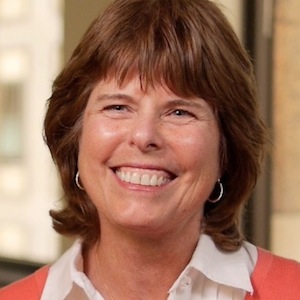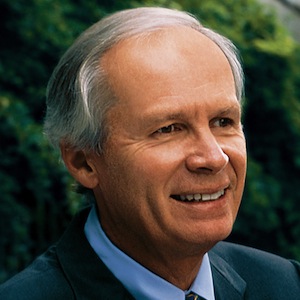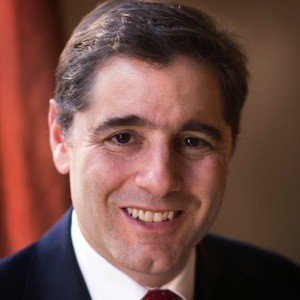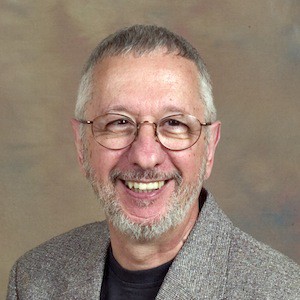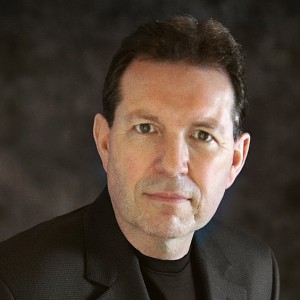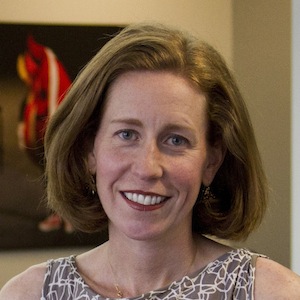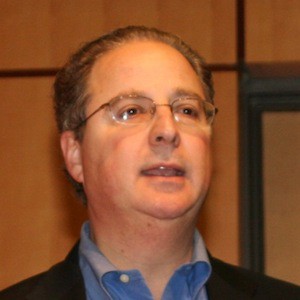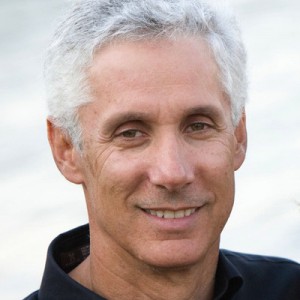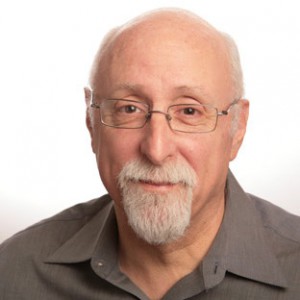Martin: Paul Sagan and Martin Nisenholtz, Cathy Yates, San Jose, April 8th, 2013. Let’s just go back a ways. Tell us when you first got into and met the Internet. How did that happen, what were you doing? I think you were at the newspaper when that happened?
Cathy: I was at the “Mercury News.”
Martin: How did you get to the “Mercury News,” what were you doing there, and then what happened to land you on the Internet side?
Cathy: OK. I actually joined the “Mercury News” right out of business school. My early career had been as an economist in D.C. Then I went to Stanford for business school, expecting to go back to Washington and return to policy analysis. Business school was my first exposure to the private sector, and I became really enamored with the idea of trying to find a niche where I could combine what I like to talk of as private sector discipline and public sector impact. That’s what got me looking at the newspaper industry. I interviewed at the New York Times, actually, but also met Tony, who was recruiting for someone to come in as his assistant. I decided to stay here in California and join him in that effort.
Martin: What year was that?
Cathy: That was in 1981.
Martin: ’81?
Cathy: 1981. There were two big bets going on in the newspaper industry at the time. One was the launch of “USA Today.” Do you remember that?
Martin: Mm hmm.
Cathy: And the other was Knight Ridder’s experiment with “Viewtron” in Coral Gables. Tony was showing me the ropes of the newspaper industry. We were talking about those two initiatives, and my response was that I thought that “USA Today” was a really smart idea and that “Viewtron” was not going to make it. He winked and nodded and said, “You’re new to the industry. We’ll see what happens.” We made a bet, and unfortunately, I’ve got to say, I think I won that bet, in terms of which endeavor persevered. Anyway, fast forward. I rose to the position of General Manager at the “Mercury News.” After “Viewtron” had shut down, I became General Manager at the “Mercury News.” My colleague Bob Ingle, who was the Executive Editor at the “Mercury News,” began talking about how we should try to revisit the experiences that “Viewtron” offered up, learn the lessons, and come at it with a second generation attempt at electronic publishing.
Martin: Were you supportive of that initially or was that something that you were skeptical of?
Cathy: I was supportive certainly of the exercise of trying to understand the lessons, but it quickly escalated beyond an analytical project to a, “Well, let’s launch Mercury Center.” First on AOL, and it happened to coincide with the time when we were under tight operating budgets, anyway. Honestly, I just didn’t see that there was much of a future in a limited, walled garden online approach. It was just too difficult, the penetration was too thin, there was nothing about it that said to me that would ever be a successful business enterprise.
Martin: What year was this, Cathy?
Cathy: This would have been, I want to say, ’93, maybe.
Martin: OK. It was just at the time that the web protocol Tim Berners Lee was developing. He actually developed it in 1990, but it’s just beginning to get known now that the web is out there.
Cathy: Yeah. I’ve never considered myself someone that sees trends early. I’ll be a fast follower, but not necessarily the person with the vision. I’ve got to credit Bob Ingle for really understanding where it could lead. On the other hand Bob’s not the best business person. He and I made kind of a good combination in this regard, because I was the skeptic and he was the visionary. Anyway, so Merc Center was born and we tried a number of different things. It was very innovative in a number of ways. But the staff knew that I was fairly skeptical about whether or not it would ever become a viable business enterprise. One day the chief marketing officer for Mercury Center called me into the boardroom and set me down. He said, “I’ve got to show you something.” What he showed me was, it was a beta version of Mosaic. I just, I said game over. That, I believe in.
I think what really was so striking to me about the Internet was the removal of boundaries. The newspaper business, as I experienced it, was always full of boundaries. It was very limited in so many ways. The manufacturing process, the distribution process, the limitations on how you package the news and the advertising always seemed to be putting up constraints that we were bumping into, even though we were an extremely profitable business. I think at the time the “Mercury News” was number one in terms of classified lineage in the country. We were always vying back and forth with “Dallas Morning News”, but I think at that point we were on top.
The Internet was just so apparently, so, just, gloriously, really, free of those constraints. That’s what convinced me, “OK, this is a game changer.” From that point on I really dedicated everything to it. I signed on to become one of the founders of Knight Ridder digital, so of course Mercury Center was part of the “Mercury News” initiative. Then Tony was looking to see if the experiment could be extended throughout Knight Ridder as an entire company. I joined Bob to put together the business plan that was the foundation for Knight Ridder Digital. That’s really how I spent the remainder of my career with Knight Ridder.
Martin: There’s another thing going on during this period, which is this little lab in Boulder, Roger Fidler’s, and we talked to Roger and we’ve just talked to Tony. What were your impressions of that at the time?
Cathy: I thought Roger was very articulate at explaining what actually the current version of an online newspaper looks like, and this is back in the early to mid ’90s. I mean it was revolutionary, it really was. He was a forward thinker and he was able to paint a vision that many people, including myself, bought into wholeheartedly. That this is the way the industry should go, could go, would go. But Roger was not able, ever really, to get any traction. He was running a think tank in a company that was all about operations and putting numbers on the board.
Paul: Arguably, and he said his biggest budget was a million dollars a year, but if you’d thrown him an infinite amount of money you couldn’t have built it then. The technology didn’t actually exist to build an iPad, which is effectively what he showed as a wooden block 25 years ago.
Cathy: Yeah, he was way ahead of the market. But he pointed the way in a very important way. He was trying to attract external money. One of the assignments I had was to go talk to some of the potential investors and get a read as to how serious they really were and advise Tony as to what could or should become of Boulder. The recommendation is that we pull it into Knight Ridder digital and use the expertise there to inform the product development that was ongoing at Knight Ridder digital.
Martin: Now we’ll get to MarketWatch and the later part of your career in a few minutes, but one of the things that’s been a persistent theme throughout this series of discussions is this tension between media or, in this case, journalism cultures and technology cultures. In technology cultures, the engineering folks are, essentially, running the agenda and the businesses. For that reason, at least in an online context, there’s a lot more innovation. In a media context or a journalism context, it’s the journalists who run the cultures. It sounds to me like, in the case of Knight Ridder, Bob Ingle crossed those two. Although I guess, at heart, he was still a journalist. There were not real engineers in the company, right? It was still a journalism culture?
Cathy: We brought in engineers at Knight Ridder Digital. We actually did implement an engineering oriented culture. I should say, more than engineering, a software oriented culture. We built out a platform and we had a major development effort that included both the platform in its entirety, but then a set of products. So the early products like Newshound, which was an early alerts service. What did we call it, Night Owl or something? It was an electronic library service. Then we had what we called Talent Agent, which was the beginning of the employment vertical that ultimately gave way to our efforts with CareerBuilder. We had this major product management function that we developed and software development operation. Bob did cross the two sides though. He was a very geeky journalist and was always interested in the technology. Of course, being here in Silicon Valley, he was an early adopter of everything, in wanting to try the latest thing on the block. That infused our culture to some extent. But that was only with regard to Knight Ridder Digital.
Ultimately, the role of Knight Ridder Digital was to try to be an instigator of change at the newspaper level. It was hard to cross that bridge from where we were. Both a separate office staff, in what had now become Knight Ridder’s corporate headquarters in San Jose, but fairly removed from all the day to day newspaper operations. It was not until near the very end of Knight Ridder’s existence that the Internet activities were deeply integrated with the print. It was never truly embraced by the publishers. Certainly not when I was there.
Paul: I’m just going to follow up on that inside outside question. A lot of companies dealt with that. Should it be separate? The conventional wisdom was, if you didn’t put it outside, it would just get killed immediately. So almost everybody started outside. But then had the experience you described, which was it was outside and it couldn’t move the mothership enough. Do you think you’d do it differently, meaning do it inside? Or would it have just died immediately? Was there another option?
Cathy: It was probably the right call to get it started, initially, as a separate entity. What ultimately created a better alignment, not a perfect alignment, but a better alignment of interests, was all around the incentives, the goals and the objectives. We went too far with our goals being independent of the print goals. It was really Hilary Schneider, when she came on board and asked Tony, “Can we give the publishers double credit for all this stuff? Because without that, they will forever see it not in their best interest to support the online.” It seemed as if any win that could be credited to the online activities was a loss for the print. It was very much of a win lose situation, instead of a win win situation. Honestly, though, that’s just part of the dilemma in the business model. The business model was broken by the Internet. It’s very difficult to be really successful at that and not do damage.
Martin: That was my point about the engineering side, Cathy. There was a theory, to follow up on Paul’s question, that by separating the unit out it could be a truly independent, large business. Essentially borrowing the brands, but not necessarily doing the same things, certainly not within the same business models. One of the questions that is continuously asked is, were these separate operations given the freedom to do what they needed to do? Or were they imaginative enough to do what they needed to do? In part, some of the folks are saying, the reason that they may not have succeeded is because they just didn’t have the engineering talent to succeed. That wraps the two points together. I would just like your opinion about that.
Cathy: I don’t think that’s the biggest problem, honestly. We could have gotten the engineering talent. We had some very good engineers. We had some very innovative thinkers. We defined ourselves as newspaper companies. Our whole mission in life was to fulfill the mission that a newspaper fulfills, which is to say bring accurate and comprehensive information to citizens of a democracy.
Martin: That is kind of fundamental?
Cathy: It is fundamental. But that’s not where you make money on the Internet. [laughs]
Martin: But the fact is, that’s not where you made money in print. In print, you made money from classified advertising. Not from serving some social mission. The question I keep asking is, lots of people figured out how to make money on the Internet. Newspaper companies, despite all of this activity, innovation and investment simply didn’t do it. I’m just wondering why. You were there. You must have thought about this. Why, from your perspective, couldn’t they do it and still fulfill their mission? Was it because Craig came along and took the oxygen out?
Cathy: Yes. That’s what was broken about the business model. Classified, which had sustained everything, went away and there was no good substitute for that. I think the dilemma was that there was not a lot of passion on anybody’s part to define ourselves as world’s best classifieds section. It wasn’t. It was limited thinking that I think I suffered from as much as anybody else. It was a struggle, and of course, you go down the slope gradually. You begin to fall a little bit and then gain speed and then gain speed and gain speed and you’re in the middle of it and it’s overtaking you before you even realize what’s happening. I think that’s what happened to the industry. While the most creative minds within the industry were struggling with the question of how do we get readers really engaged in online news, what was happening was that the classified business was going out the door.
Martin: We talked to Tim Landen and clearly the industry learned a lot from CareerPath and that failure, built CareerBuilder and then Classified Ventures, which were real successes in their day. Now, obviously today, they’re more complex, but for a period of time, the industry did manage to have some true successes and yet it still didn’t matter.
Paul: It turned dollars into nickels.
Cathy: I don’t know if there is any fixing the model.
Martin: That’s the other theme that continuously comes along, which is we’ve been working with this metaphor called “the tide and swimmers.” The tide is technology and its inexorable march. The swimmers are the people like you and others who made decisions in the midst of all that. The question becomes could you, even if you were Olympic swimmers, have made any difference in a tide that was so difficult, so harsh. Or were the decisions made, the movements made during this period simply the wrong ones? If you had swum in a different direction or taken a different course, might’ve gotten to calmer seas, just as a horrible extension of that metaphor.
Cathy: In retrospect, I guess I feel as if had it been possible for this transformation to have occurred, it would’ve happened. With all of the money, the dedication, the bright minds that the talent that existed in the newspaper industry, and I’m not just talking about Knight Ridder, I’m talking about across the entire industry, there hasn’t been a huge success. Everybody’s troubled. There have been obviously, in the New York Times, the Wall Street Journal, two enterprises that today are stronger than most of the players in the field. But it’s still not a thriving business in the way that you see companies like Google and the Internet giants that have emerged. I think it was structural to the industry.
Martin: Let’s talk about MarketWatch for a couple of minutes because you leave Knight Ridder in what year?
Cathy: ’99.
Martin: Larry Kramer, whom we talked to at some length, recruited you to be the chief operating officer, I think it was, in MarketWatch.
Cathy: Yes.
Martin: What made you jump to that company?
Cathy: Before I went to MarketWatch, I went to Women.com.
Martin: Oh, that’s right, yeah.
Cathy: Women.com was then acquired by iVillage. I went to Women.com and here was my thesis. I wanted to go to a pure Internet company that wasn’t hampered by the requirement of protecting the mother ship. At the same time, I really believed in the value of brand. Women.com was sitting there with the partnership with Hearst magazines. They were the online face of all the Hearst titles. Yet, it was a standalone Internet company. I thought that it had the right ingredients for a very rich exploration of what that combination could look like, the real brand loyalty that comes with the content up from a print publication, but the freedom to operate like an Internet company. What I found was that some of that was possible to explore at Women.com. Really what the business was primarily about was pop culture and eyeballs. It was not really mission driven and I missed that. That’s why I joined the newspaper business.
I was interested in returning to a culture that had mission at its core. When the acquisition of Women.com by iVillage became, it wasn’t announced yet, but it was apparent, that’s when I started looking around. Larry and MarketWatch really appealed to me because, for one thing, we spoke the same language. Larry had come out of the newspaper business and as you know, grew up on the editorial side. I always had found the ability to form really strong partnerships with people on the editorial side when I brought to the table my operating experience.
He’s a captivating person anyway with a big vision of how this site could really change the game for individual investors in way that print never could. It was capitalizing on all of the advantages, the technological advantages, that came from the Internet to do something new in terms of information distribution that really served a social purpose. That was why I joined MarketWatch.
Paul: Did you uproot from the west coast and moved to New York or did you stay here?
Cathy: No, they were headquartered in San Francisco.
Paul: Was Women.com as well?
Cathy: Women.com was headquartered in San Mateo.
Paul: Because iVillage was…
Cathy: IVillage was in New York and they acquired Women.com but no, Women.com was in San Mateo. I’ve been in the Bay Area, with the exception of one stint in Miami, ever since I graduated from business school. I didn’t know this when I came into MarketWatch, but the founder of BigCharts, Jamie Thingelstad, who had been acquired by MarketWatch and the BigCharts technology became the backbone of the MarketWatch website. Then Jamie had left and was not with MarketWatch when I joined them. We needed a CTO and I, at Larry’s suggestion, opened up a conversation with Jamie and was able to entice him to come back to MarketWatch. This is where the combination of both editorial vision and passion and really vassel technology expertise came to fruition, at least for me. It was really a very, very dynamic combination. Jamie was a young whiz kid and he was very innovative and very cutting edge in terms of his thinking about technology and how it could be deployed all the time. Of course, Larry had a very big editorial vision. Those two ingredients were a powerhouse for MarketWatch. They really were.
Martin: Do you think it requires an entrepreneurial environment for that to happen?
Cathy: Oh yeah, absolutely, but there’s always a tension. You need an entrepreneurial culture to allow the ideas to take root, but then you need some discipline and some structure to allow them to survive unless you happen to step into something that’s really just very organic and spins off cash unbelievably, and we all know companies that have done that. The normal experience in building a company.
Martin: I guess the question is, at least so far, we haven’t yet run across anyone on the entrepreneurial side who has created the possibility for this mission driven notion in local regional journalism. We’re seeing it in business journalism and MarketWatch in places perhaps like Business Insider or others. The places that doggedly cover the City Hall and the local businesses and those sorts of things, the kind of thing that happened at the Boston Globe, for example, with the Catholic church, those things we’re struggling still to find. Why do you think that is? Try and put the Knight Ridder experience together with the MarketWatch experience and tell us why. Is it the structural point that you made before?
Cathy: Well, let me make sure I understand your question. You’re asking why is it that entrepreneurs don’t go after the local space?
Martin: They have. I’m asking why no one has yet…
Cathy: Succeeded.
Martin: …through all this time, succeeded in a big way. Right, or in any way that I can see. Maybe you think Patch is doing it. I’m sure not sure it is. If there’s an example that you think fulfills that mission that you described before, tell me what it is and we’ll go talk to them.
Cathy: No, I’m not aware of any. That’s why I said if it were possible to break the model, If you define newspapers as being fundamentally local media, and if it were possible to find a way to support that endeavor in an Internet business structure, I think you would’ve seen it emerge, but I haven’t seen it emerge. I think part of it is the nature of the audience. What we were trying to do at Knight Ridder was to create the possibility and we knew we could never do it entirely on our own, but to create the possibility of a national network of local sites. That’s what Real Cities was all about, with the idea that in order to play in the Internet advertising game, you really had to have scale. Yet for a variety of reasons, structural reasons, political reasons, it just never worked. It didn’t work with AOL, it didn’t work with Knight Ridder, it hasn’t worked with any other string or network of local sites that I’m aware of. I guess it comes down to the nature of the audience and how difficult it is to be able to aggregate an audience around a local theme.
Fundamentally, what the newspapers industry was most advantaged by was the cost of setting up printing presses and a distribution network of trucks. We should all be honest about that. That’s what allowed the economics of the industry to be so plentiful for so long. It was because there were huge barriers to entry, but they’re just not there on the Internet. The audiences that do exist, the passionate audiences that exist on a local scale, are all just very, very small and they’re all about very, very local voices.
Martin: Anything that you have, Paul?
Paul: No. It’s a great summary of the dilemma.
Martin: Yeah. Anything else, Cath, that you want to…
Cathy: Well, let me ask you, guys, turn the tables. Where do you think it goes? You’re trying to synthesize a perspective of history. If you were to turn it around and say, “Where does the future road take us?”, what are your thought about that?
Paul: I think it’s still a scary road, because I think so much of the economic underpinnings was just yanked out of, certainly, the big city dailies and in the middle, that’s the biggest prob. You mentioned the two biggest, do they have a national footprint and there’s still some belief in hyper or small markets. Obviously Warren Buffet is making those bets. I’m not convinced those sustain themselves, either. The middle has gotten hollowed out, whether it’s Chicago, LA, Philadelphia, New Orleans, now, and I don’t see what replaces that. I’m not worried about the advertising audience, I’m not worried about the entertainment audience, but I’m worried about the news part of it. How do we keep watch on city hall? I don’t think corruption went down because the Internet grew. I just think it’s harder not if someone’s not following you around looking it’s a lot more bad things happen. That was simply for a long time a subsidized job, and that subsidy went away, and it doesn’t easily come back.
Cathy: How do you put a value on, do you think?
Paul: Onto democracy, potentially?
Cathy: No, on the job that a good investigative reporter does.
Martin: Well that’s a good question. I think that’s the question. I see your point about the citizens. I think that there is a model, if people are willing to step up and pay for the content that matters to them in communities. I don’t think, and I could be wrong about this, but at this point I don’t think, I don’t see the kind of robust advertising model that existed in a lot of media being replicated in digital, at least not for content in local markets. That could happen, but so far it’s not. Then the question becomes how do you size a business to some series of revenue streams, whether it’s some light advertising plus some willingness to pay? I think when you do that math you get to a very small staff, let’s just put it that way. This is where the road forks. Some people believe that given the blogosphere and Twitter and other citizen journalism mechanisms, coupled with a small staff, you can fulfill fundamentally the mission that is necessary. Other people think that’s ludicrous. We won’t know, I don’t think, until some set of people begin to try. One of the folks that we interviewed, Tim Landen, who was at the Tribune for many years, is trying. We’ll see what he comes up with.
As I said Patch, an AOL venture which is much more top down, much more, obviously, sponsored by Tim Armstrong who we intend to talk to during this process has a different model. But to your point, certainly nothing has emerged yet that we could point to that fulfills that particular mission?
Paul: I think consumers have a very different view of value when they’re eating à la carte than when they’re at the buffet, and that newspaper was a bundle. I don’t think you could say, “You paid us this amount, now tell me what each component was worth,” because they valued not all of the bundle but some number of things that came in the paper or, frankly, the weekly magazine. It’s not just newspapers, but newspapers are easy to focus on that bundle. To say to them, “Now, if you could only have that component, what would you pay for it?” I don’t think people have any way to frame it. Investigative journalism is the hardest part, because it’s not even predictable. You can’t guarantee that you’ll deliver every day.
Cathy: The role of the publisher, let’s face it, is to aggregate packages of content around their target audience’s interests.
I’ve wondered whether there could at some point be in the future certainly the technology exists to do it today but a real time content exchange, where publishers are able to acquire content that they would then distribute to their audience by purchasing, basically, publishing rights off of the content exchange.
Martin: NewsCred is that exchange. It just doesn’t have much local information [laughs] on it, as I understand it. I could be wrong about that, but…
Cathy: I would say that there just isn’t enough demand at a local level to sustain much of a price [laughs] for locally specific information. But in the world in which you have a real time content exchange, of course, the type of redistribution rights or publishing right, as well as the expertise of the writer, could be factored into whatever price has been paid.
Martin: The other point that Tony made, which I think is worth reiterating here, is that Warren Buffet has invested in certain community newspapers, and those communities seem to have the coherency, the stability, and the support for the print product as well as the online version of that print product. They seem to have a loyalty that you don’t find in a larger, more spread out, let’s just say, metropolitan community.
It’s possible that all local communities aren’t created equal. I don’t know enough about how well Buffet’s newspapers are doing to know whether…
Paul Sagan: It’s a niche or segment.
Martin: …niche, or whether he’s even buying them for the real estate. Who knows why? [laughs] He’s an investor. I don’t know. But whatever…
Paul: It will play itself out.
Martin: Yeah, that will play itself out.
Paul: It is a financial place, not a new model.
Martin: No, it’s not a new model. No.
Cathy: No, I think it’s remnants of an old model that can continue to persist in some pockets. I grew up in a Navy family, and the shorthand for where I grew up is New London, Connecticut, because my father was there in the submarine base. New London “The Day” has got fierce loyalty among its readership. Of course, it is a family foundation, so they don’t have as much pressure as many of the other newspaper companies. They seem to be about the same size as when I was growing up, so they didn’t expand hugely and then contract. They’re probably able to pay the bills, but not a huge operating margin.
I think one of the things that was a detriment to the industry was that everybody got used to such high operating margins, and that became the standard around which everyone’s thinking aligned with regard to what needed to be produced. I think that might have also put some blinders on people in terms of the long term viability of the industry.
We waited too long to try and defend those kinds of margins.
Martin: Let me just ask one last question and then we’ll be out of your hair. How difficult were the cultural issues at Knight Ridder? The company no longer exist, so there’s not a lot of…Tony talked a lot about the inability for the print side of the business to fully embrace this.
Paul: Church and state.
Martin: Yeah. Was the innovator’s dilemma really the key or core issue in some ways, do you think, or was that not, from your perspective, that important?
Cathy: I think the innovator’s dilemma was very real, but I think it went beyond the innovator’s dilemma. You mentioned church and state. It wasn’t just a radical transformation. The base is competition and what customers were after, which of course is what the innovator’s dilemma speaks to. It was also the idea that there was something that was unworthy about the commercial side of the business, whereas the point of view that was all about “news for the sake of news.” Truly, there was an element of that culture at Knight Ridder as well.
That was a cultural war that went beyond the innovator’s dilemma and compounded the issue. I think that, more than anything, is why there was a lack of passion in myself among others to become the world’s best classified advertising vehicle.
It just didn’t speak to the higher purpose that so many people were in the industry to try and nurture. That created a disincentive for us to really be doing the kinds of things that we would need to do to, say, invest all of our energy in fixing the classified problem.
Had we done that, would we have been able to do it? I don’t know. It’s pretty hard to compete against free, but you can certainly build off of the traffic that comes from having a free classified product, and we should have known that.
We knew that the little liner ads in there attracted a lot of readership, attracted a lot of loyalty, and brought people to the newspaper. There were a lot of people that had subscribed to the paper just for that. But we didn’t embrace that, and I think that was a cultural problem that existed in the industry. For all of us.
